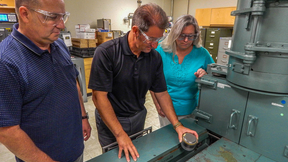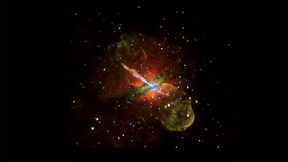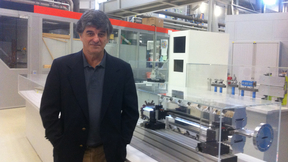Back
The smooth blue sphere of the National Ignition Facility's (NIF) target chamber bristles with diagnostics — nuclear, optical and X-ray instruments that together provide some 300 channels for experimental data. These diagnostics provide vital information to help NIF scientists understand how well an experiment performed.Two of these diagnostics, known as Dante 1 and Dante 2…
Located one-and-a-half floors underground in LLNL's Bldg. 151, the Nuclear Counting Facility (NCF) leverages its well-shielded, low-background environment to accurately measure nuclear materials for the National ignition Facility (NIF) and a variety of other Laboratory programs.The NCF has been providing high-sensitivity radiation measurements since the inception of…
Using ever more energetic lasers, Lawrence Livermore researchers have produced a record high number of electron-positron pairs, opening exciting opportunities to study extreme astrophysical processes, such as black holes and gamma-ray bursts.By performing experiments using three laser systems — Titan at Lawrence Livermore, Omega-EP at the Laboratory for Laser Energetics …
Growing up in a household of artists and engineers, Peter Thelin was destined for a career in which artistry mattered. Only for him, art has come in the form of manipulating the shapes, sizes and qualities of optics. And now, as one of the few remaining practitioners of hand-polishing optics, Thelin is passing his artistry along to the next generation of optics specialists…
LLNL Distinguished Scientist Omar Hurricane, chief scientist for the Laboratory’s Inertial Confinement Fusion (ICF) program, is at the forefront of the drive to achieve nuclear fusion with energy gain for the first time in a laboratory. In a wide-ranging interview with NIF & Photon Science News, Hurricane outlines the NIF strategy for moving toward ignition and…
Congressman Eric Swalwell visited the Laboratory Monday to witness an experiment at the National Ignition Facility (NIF).After an initial overview by NIF Director Mark Herrmann, Swalwell was greeted by Lab Director Bill Goldstein, Livermore Field Office Manager Nicole Nelson-Jean and NIF & Photon Science Principal Associate Director Jeff Wisoff.The group moved to the…
For several years, the National Ignition Facility (NIF) at Lawrence Livermore National Laboratory (LLNL) has pursued an indirect drive approach to ignition, using cylindrically shaped gold cans known as hohlraums.In this configuration, all of NIF’s 192 laser beams enter the hohlraum through a pair of laser entrance holes and deposit their energy on the gold (or depleted…
You may think the aisles in your neighborhood convenience store are crowded, but they’d look positively spacious compared to the passageways in the NIF target bay.The target bay bristles with dozens of instruments needed for NIF experiments, ranging from inserters that hold NIF targets in place to cameras and other diagnostics that record the results of NIF shots. Fitting…
On April 1, 1995, the Hubble Space Telescope, now celebrating its 25th anniversary, captured the famous images of the "Pillars of Creation" in the Eagle Nebula. Twenty years later to the day, the NIF Team conducted the first experiment in a new Discovery Science campaign aimed at finding clues to the mystery of how stars are born in these spectacular cosmic formations…
In National Ignition Facility (NIF) inertial confinement fusion (ICF) experiments, the fusion fuel implodes at a high speed in reaction to the rapid ablation, or blow-off, of the outer layers of the target capsule. To reach the conditions needed for ignition, the fuel must implode symmetrically at a peak velocity of about 350 kilometers per second— without producing…
More than 50 years ago, when the laser was a mere 5 years old, laser physicists dreamed of the development of an X-ray laser to expand the frontier of knowledge.The concept goes back to the mid-1960s, when scientists realized that laser beams amplified with ions would have much shorter wavelengths than beams amplified with gas.Instead of trying to make a laser oscillator,…
Lawrence Livermore National Laboratory (LLNL) has installed and commissioned the highest peak power laser diode arrays in the world, representing total peak power of 3.2 megawatts (MW).The diode arrays are a key component of the High-Repetition-Rate Advanced Petawatt Laser System (HAPLS), which is currently under construction at LLNL. When completed, the HAPLS laser system…
A key component of the High-Repetition-Rate Advanced Petawatt Laser System (HAPLS) under construction at LLNL has been installed and commissioned. The new Gigashot-HE diode-pumped solid-state (DPSS) laser system will be used as a pump source for one of HAPLS’ high-energy titanium-doped sapphire (Ti:Sapphire) amplifier stages.When commissioned to its full design performance…
The study of material properties under the conditions of extreme high pressures and strain rates is important for understanding meteor, asteroid or comet impacts, as well as in hypervelocity impact engineering, inertial confinement fusion (ICF) capsules, and basic high energy density (HED) physics. In a recent study published by Physical Review Letters, a team of LLNL…
A systematic study of the effects on National Ignition Facility (NIF) implosions of the ultra-thin mounting membranes that support target capsules inside NIF hohlraums was reported by LLNL researchers in a Physics of Plasmas paper, published online Feb. 4.The performance of NIF’s inertial confinement fusion targets depends on the symmetric implosion of highly compressed…
Fans of the popular TV series "CSI" know that the forensics experts who investigate crime scenes are looking for answers to three key questions: "Who did it; how did they do it; and can we stop them from doing it again?"The field of nuclear forensics, an important element of LLNL’s national security mission, has similar goals and uses similar techniques — but with even…
New laser-driven compression experiments reproduce the conditions deep inside exotic super-Earths and giant planet cores, and the conditions during the violent birth of Earth-like planets, documenting the material properties that determined planet formation and evolution processes.The experiments, reported in the Jan. 23 edition of Science, reveal the unusual properties of…
Matthew Levy, a Lawrence Scholar in the Physics Division at Lawrence Livermore National Laboratory (LLNL), has been awarded the prestigious Newton International Fellowship by the Royal Society of the United Kingdom (UK).The highly competitive fellowship program makes 40 awards per year across all disciplines of the sciences and humanities, providing the opportunity for the…
The generation of cosmic magnetic fields has long intrigued astrophysicists. Since it was first described in 1959, a phenomenon known as Weibel filamentation instability -- a plasma instability present in homogeneous or nearly homogeneous electromagnetic plasmas -- has generated tremendous theoretical interest from astrophysicists and plasma physicists as a potential…
The Lawrence Livermore National Laboratory’s Industrial Partnerships Office recently honored former Lab scientist Luis Zapata for his contribution to a technology known as laser peening.Zapata received the Excellence in Technology Commercialization Award, which recognizes his outstanding technical contributions to the development of an LLNL laser system. Zapata was the…
























